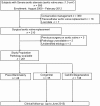Clinical impact of pathology-proven etiology of severely stenotic aortic valves on mid-term outcomes in patients undergoing surgical aortic valve replacement
- PMID: 32155164
- PMCID: PMC7064191
- DOI: 10.1371/journal.pone.0229721
Clinical impact of pathology-proven etiology of severely stenotic aortic valves on mid-term outcomes in patients undergoing surgical aortic valve replacement
Abstract
Background: The use of transcatheter or surgical aortic valve replacement (AVR) for severe aortic stenosis (AS) has considerably increased in recent years. However, the association between AS etiology and mid-term clinical outcomes after surgical AVR has not been fully investigated.
Methods and results: We retrospectively included 201 patients (mean age, 75 years; 43%, men) who underwent surgical AVR for severe native AS (aortic valve area ≤1.0 cm2 on preoperative transthoracic echocardiography examination). The following valve etiologies were postoperatively identified on pathological examination: post-inflammatory (n = 28), congenital (n = 35), and calcific/degenerative (n = 138). The median follow-up interval was 4.1 years following surgical AVR. Of the 201 patients, 27% were asymptomatic, 40% had a history of heart failure, and 11% underwent previous heart surgery. The cumulative incidence of cardiac events (all-cause death, aortic valve deterioration requiring repeated AVR, and hospitalization for heart failure) and combined adverse events, which included non-fatal stroke, unplanned coronary revascularization, pacemaker implantation, and gastrointestinal bleeding along with cardiac events, was significantly higher in the calcific/degenerative group (p = 0.02 and p = 0.02, respectively). In multivariate analysis adjusted for age, sex, renal function, heart failure, atrial fibrillation, concomitant surgical procedures, and EuroSCORE II, AS etiology was independently associated with an increased risk of combined adverse events (congenital vs. post-inflammatory: hazard ratio [HR], 4.13; p = 0.02 and calcific/degenerative vs. post-inflammatory: HR, 5.69; p = 0.002).
Conclusions: Pathology-proven AS etiology could aid in predicting the mid-term outcomes after surgical AVR, supporting the importance of accurate identification of severe AS etiology with or without postoperative pathological examination.
Conflict of interest statement
NO authors have competing interests.
Figures




Similar articles
-
Incremental Prognostic Use of Left Ventricular Global Longitudinal Strain in Asymptomatic/Minimally Symptomatic Patients With Severe Bioprosthetic Aortic Stenosis Undergoing Redo Aortic Valve Replacement.Circ Cardiovasc Imaging. 2017 Jun;10(6):e005942. doi: 10.1161/CIRCIMAGING.116.005942. Circ Cardiovasc Imaging. 2017. PMID: 28559420
-
Surgical Enlargement of the Aortic Root Does Not Increase the Operative Risk of Aortic Valve Replacement.Circulation. 2018 Apr 10;137(15):1585-1594. doi: 10.1161/CIRCULATIONAHA.117.030525. Epub 2017 Nov 22. Circulation. 2018. PMID: 29167226
-
Predictive factors of long-term survival in the octogenarian undergoing surgical aortic valve replacement: 12-year single-centre follow-up.Heart Vessels. 2016 Nov;31(11):1798-1805. doi: 10.1007/s00380-016-0804-3. Epub 2016 Feb 3. Heart Vessels. 2016. PMID: 26843194
-
Imaging for Predicting and Assessing Prosthesis-Patient Mismatch After Aortic Valve Replacement.JACC Cardiovasc Imaging. 2019 Jan;12(1):149-162. doi: 10.1016/j.jcmg.2018.10.020. JACC Cardiovasc Imaging. 2019. PMID: 30621987 Review.
-
Impact of the indexed effective orifice area on mid-term cardiac-related mortality after aortic valve replacement.Heart. 2010 Jun;96(11):865-71. doi: 10.1136/hrt.2009.177220. Epub 2010 Apr 20. Heart. 2010. PMID: 20406767 Review.
References
-
- Rajamannan NM. Cardiac valvular medicine. Dordrecht: Springer; 2013; 59–61
MeSH terms
LinkOut - more resources
Full Text Sources
Research Materials

